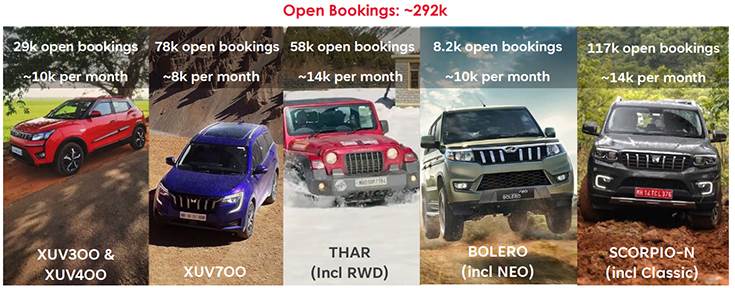Mahindra & Mahindra (M&M) has reported wholesales of 32,883 SUVs in May 2023, which is a 23% year-on-year increase (May 2022: 26,632 units) but 5.21% down on April 2023’s 34,694 SUVs. The company also sold three sedans/vans last month, down 99% on May 2022’s 272 units.
Cumulative sales for the first two months of FY2024 are 67,584 units, up 37% YoY (April-May 2022: 49,430 units).
 Like Maruti Suzuki India, M&M also continues to be impacted by semiconductor supply constraints on specific parts like airbag ECU. According to Veejay Nakra, President, Automotive Division, M&M, “The sales volume for both SUVs and Pik-Ups was restricted by a short-term disruption in engine-related parts at the supplier end. The semiconductor supply constraints on specific parts like airbag ECU continued during the month too.”
Like Maruti Suzuki India, M&M also continues to be impacted by semiconductor supply constraints on specific parts like airbag ECU. According to Veejay Nakra, President, Automotive Division, M&M, “The sales volume for both SUVs and Pik-Ups was restricted by a short-term disruption in engine-related parts at the supplier end. The semiconductor supply constraints on specific parts like airbag ECU continued during the month too.”
In the electric vehicle segment, the Mahindra XUV400 has clocked retail sales of 363 units in May 2023, adding to the 526 units it sold in April 2023. Its cumulative sales of 889 XUV400s gives it a 6.64% share of the EV market, giving M&M second place behind market leader Tata Motors (10,274 units / 77% share) and ahead of MG Motor India (779 units / 5.82% share).

Order backlog up by 32,000 units since November 2022
Meanwhile, the order backlog at M&M has increased to 292,000 cars. On November 1, 2022, the company had pending orders of 260,000 units. The rise of 32,000 units over seven months hints that demand for the company’s range of SUVs continues to outstrip its production capacity.
On May 26, the company revealed that it has open bookings of 292,000 units with customer enquiries holding steady with low cancellations. Of this, the Scorpio N with 117,000 bookings is the one with the biggest backlog and accounts for 40% of overall bookings. Flagship XUV700, with 78,000 bookings, has 27% and is followed by the Thar (58,000 bookings), the XUV300 / XUV400 (29,000 bookings) and the Bolero (8,200 bookings).
M&M has already expanded its SUV manufacturing capacity from 29,000 units per month to 39,000 units by December 2022 and plans to further increase it to up to 49,000 units in the current financial year or 600,000 units per annum.
